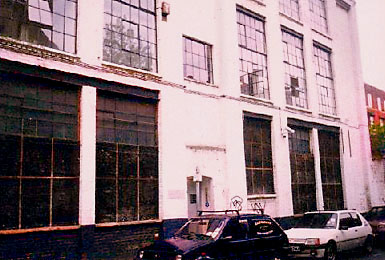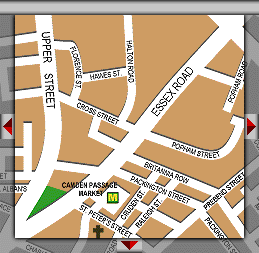|
Britannia Row Studios, London by Mike McInnis Animals stands alone as the only Pink Floyd album recorded entirely at Britannia Row Studios, which was at one time owned entirely by the band. After touring North America twice in the spring of 1975, and after a disastrous performance at England's Knebworth Festival that July, the Floyds had decided that it wouldn't do to keep storing their vast touring equipment in a rented garage. The band also was interested in keeping its growing crew and staff under contract, rather than cutting them loose and running the risk of their having become employed elsewhere when it came time to tour again.
The Floyds purchased a one-time chapel building on Britannia Row, a side street in Islington, North London, not far from Roger Waters' home. Britannia Row Productions, Inc. was created, and members of the touring crew were hired in various capacities. As a way to make some return on the band's investment in its sophisticated touring equipment, Britannia Row Productions also rented out PA and lighting, as well as technicians to operate them, under the guises of Britannia Row Audio and Britannia Row Lighting. In addition to storage space, the building on Britannia Row included offices for the staff, as well as a demo and rehearsal studio. In 1976, the Floyds began upgrading it to a full studio so they could record at their own pace without paying for studio time at Abbey Road. But in the days in which Animals was recorded, the studio facilities left much to be desired, at least by the Floyds' superstar standards. The studio walls were lined with simple Lignacite brick, which had notoriously poor acoustics, and the recording and mixing equipment was composed largely of standard "off the shelf" equipment. Brian Humphries, who had worked with the Floyd as an engineer on Ummagumma, More, Zabriskie Point, the 1974 and '75 tours of Britain and North America, as well as Wish You Were Here, was the original overseer of the studio facilities. A young engineer named Nick Griffiths was hired as his assistant. When Humphries and the rest of Britannia Row Productions staff went on tour with the Floyd in January 1977, Griffiths alone was left in charge. He was largely responsible for outfitting Britannia Row Studios with custom-made, state-of-the-art equipment.
In 1978, the London music press reported that Pink Floyd had booked Britannia Row Studios for six straight months to record the album which would eventually become The Wall. Such lengthy studio tenures are precisely why the group wanted to have its own studio, and why the studio had such limited success as a commercial venture--you can't rent out the studio facilities if the landlords are using them! Though the band did do some early work on The Wall at Britannia Row Studios, the majority of the album was recorded in France and Los Angeles, in order to avoid the UK's hefty income taxes. Likewise, the studio is not listed on the album cover for tax reasons. But Nick Griffiths did record some of The Wall's sound effects at Britannia Row, even while the band was working abroad. "And we got a lot of crockery in the studio," Griffiths told Floyd biographer Nicholas Schaffner, "set the microphones up, and got the twenty-four track going, and smashed everything in sight, threw it against the wall--which was actually used on the film, but not on the album in the end." Griffiths recruited the children for "Another Brick in the Wall, Part 2" from the Islington Green School, located around the corner from Britannia Row facilities. The Floyds weren't there, but Griffiths brought an entire music class (and its teacher) to the studio to record the now-famous chorus, under Griffiths' enthusiastic direction.
Eventually, however, the Floyds seemed to grow tired of their studio, though it still gets used from time to time. The Final Cut was recorded piecemeal at a number of studios, but not at all at Britannia Row. Work on A Momentary Lapse of Reason was begun on David Gilmour's houseboat studio, the Astoria, but some recording was done at Britannia Row. And the infamous four-man jam sessions that led to The Division Bell took place at Britannia Row in January 1993, although this time around most of the album was actually recorded elsewhere. Originally, the studio was owned jointly by all four Floyds. When Rick Wright was forced out of the band in 1979, he sold his stake in the studio to the others, as did Waters when he formally quit the group in 1985. Eventually, Gilmour sold his interest to Nick Mason. Of all the Floyds, Mason has perhaps the strongest ties to Britannia Row. He produced Michael Mantler's 1976 album The Hapless Child there, as well as The Damned's Music for Pleasure (which, incidentally, was Nick Griffiths' first engineering gig at Britannia Row). And in July 1977, fresh off the Animals tour, Mason recorded there as the drummer for the Gary Windo All-tars. (Windo would later appear on Mason's Fictitious Sports album in 1981.) Mason's second solo outing, Profiles (with 10cc guitarist Rick Fenn), was recorded and mixed largely at Britannia Row. When the Floyd hired him, Nick Griffiths was a 20-something engineer. These days, his work with Pink Floyd is just one part of his impressive resume as an engineer and producer. He is one of Roger Waters' favorite co-producers (working on all of Waters' solo projects since 1986), and he used his experience in managing Britannia Row in designing a private studio in Hampshire for Roger Waters, and in heading a team responsible for remodeling Last Beat Studios in Dallas. Mike McInnis is a staff writer for Spare Bricks
|


